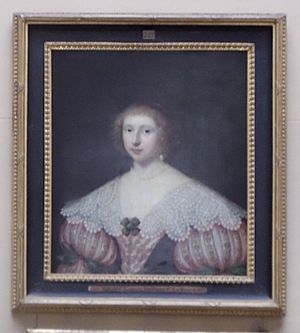Margaret Howard, Countess of Nottingham facts for kids

Margaret Stuart (born around 1591 – died 4 August 1639) was an important Scottish noblewoman. She lived in England and worked at the royal court. Margaret was a lady-in-waiting to Queen Anne of Denmark, who was the wife of King James I. Her parents were James Stewart, 2nd Earl of Moray, and Elizabeth Stuart, 2nd Countess of Moray. Her brother was Sir Francis Stuart, a sailor and supporter of the writer Ben Jonson.
Contents
Becoming a Lady of the Court
In 1602, there were talks in Scotland about Margaret getting married. Queen Anne of Denmark suggested that Margaret, who had recently joined the queen's court, might marry Lord Gordon. This plan was part of a bigger idea to settle disagreements between powerful Scottish families.
After King James VI of Scotland also became King James I of England in 1603, Margaret moved to England. She was chosen to be a lady in the queen's special "drawing chamber." This meant she was close to the queen. In September 1603, the queen ordered new clothes for Margaret and other Scottish ladies who had traveled south.
First Marriage and Royal Life
In September 1603, Margaret married Charles Howard, 1st Earl of Nottingham. He was much older than her, and their marriage was quite a topic of conversation among important people like Queen Anne and her brother, Christian IV of Denmark. Queen Anne even joked that their marriage was like "Mars and Venus" coming together, referring to the Roman gods of war and love.
King James gave Margaret a home called Chelsea Place and a yearly payment of £600.
Margaret and Charles had two children:
- Charles Howard, 3rd Earl of Nottingham
- Anne Howard (born around 1612), who married Alexander Stewart, Baron Garlies.
Playing a Role in a Royal Show
In January 1604, Margaret took part in a special play called a masque, titled The Vision of the Twelve Goddesses. She played the part of Concordia, who represented peace and agreement. She wore red and white clothes, which were the colors of England and Scotland joined together. Her outfit had clasped hands sewn onto it, and she carried a bush with red and white roses. Her role in the masque was a symbol of the new union between England and Scotland.
Later, in December 1604, Margaret was unable to perform in another masque called The Masque of Blackness because she was ill and needed surgery. She did not appear in any more court masques after that.
Gifts from Spain
Margaret's husband, the Earl of Nottingham, was involved in important talks with Spain in 1604, which led to the Somerset House Conference. When the treaty was finalized, the King of Spain, Philip III, gave many valuable gifts. Margaret received a gold chain with diamonds, small portraits of the Spanish King and Queen, a special box decorated with diamonds, and even perfumed gloves.
A Royal Misunderstanding
In 1606, Queen Anne's brother, King Christian IV of Denmark, was leaving London. He had an argument with Margaret's husband, the Earl of Nottingham, on a ship. The Danish king kept showing two fingers, saying it was two o'clock. Margaret and her husband thought he was making fun of their age difference. This led to an angry exchange of letters.
Margaret wrote a strong letter, saying she did not deserve the name King Christian had called her. Queen Anne of Denmark was very upset and asked King James to send Margaret away from court. The French ambassador, Antoine Lefèvre de la Boderie, also wrote about the argument, noting the age difference between Margaret and her husband. He mentioned that Margaret, who was pregnant at the time, felt that King Christian and Queen Anne were laughing at her.
Despite this quarrel, Margaret seems to have quickly returned to the queen's good graces.
Life at Court Continues
Like many people at court, Margaret gave Queen Anne gifts on New Year's Day. For example, on 1 January 1609, she gave the queen a beautiful satin petticoat. It was embroidered with grapes, roses, pansies, birds, clouds, and even bats.
In February 1613, at the wedding of Princess Elizabeth and Frederick V of the Palatinate, Margaret was involved in another incident. She had a disagreement with the French ambassador's wife about where they should sit at dinner. Margaret held the ambassador's wife's hand and wouldn't let go throughout the meal!
When her husband, the Earl of Nottingham, retired from his role as Lord Admiral, he was declared the most important earl in England. However, when Queen Anne of Denmark died in 1619, other noblewomen argued about who should have the highest rank at the funeral, refusing to let Margaret go first.
Her Possessions
In 1606, a list was made of the valuable items Margaret and her husband owned. This list gives us an idea of the luxurious things wealthy people had during that time. It included many buttons set with diamonds and rubies, a special flask for musk perfume, and various silver items like a lemon squeezer and dishes for sausages and eggs. They also had a silver sugar box shaped like a seashell and fancy bed curtains made of velvet. A painting of Margaret shows her in a rich room, wearing beautiful lace.
Second Marriage and Later Life
After her first husband died, Margaret married William Monson, 1st Viscount Monson in October 1625. They did not have any children together.
Margaret died at her home in Covent Garden on 4 August 1639. She was buried in Chelsea.
Images for kids
-
Margaret Howard, Countess of Nottingham, by Cornelius Johnson, (Dunrobin Castle)


